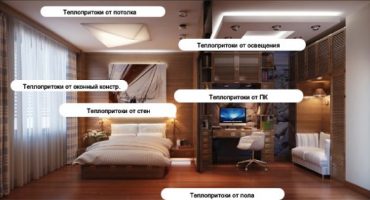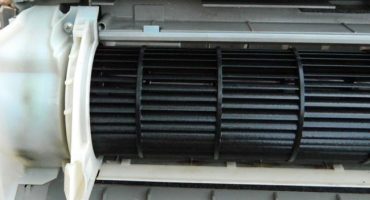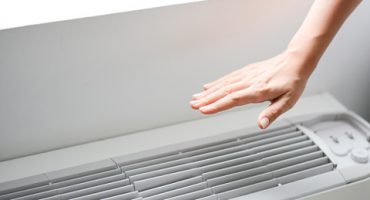- What you need to install the air conditioner yourself
- How to independently install air conditioning in the apartment
- How to connect blocks
- How to connect the air conditioner to the mains
- Height from air conditioning to ceiling
- How to install a mobile air conditioner
- Installing an air conditioner without a vacuum pump
- Installation of air conditioning on high floors
- Air conditioning installation requirements
- What is the maximum length of the air conditioner
- How to hide air conditioning in the interior
Installation of an air conditioner requires experience in such work, as well as theoretical training. In most cases, a malfunction of this system occurs due to non-compliance with the installation and connection rules.
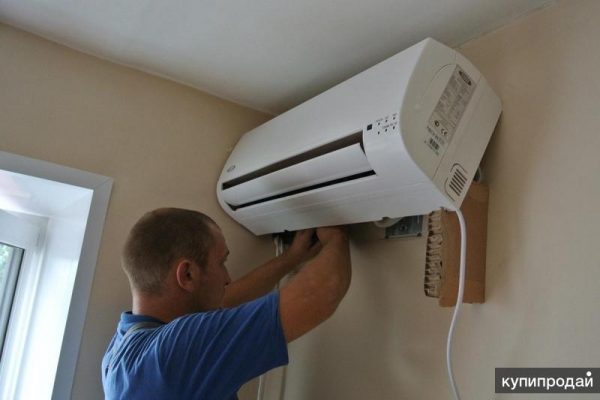
Self-installation of air conditioning
Before installing the air conditioner, you should know the sequence of steps:
- Choosing a place to install.
- Hang the indoor and then the outdoor unit.
- Laying communications.
- Setting up the correct operation of the system.
What you need to install the air conditioner yourself
In order to do all the work yourself, you will need a set of tools. For installation you will need:
- High power hammer drill. Through it, through holes are made that allow pipes and cables to be connected to the bundle of the outdoor and indoor units.
- Pipe cutter. It is useful for cutting copper pipes. You will also need a file that removes burrs on the pipes.
- Pipe bender or spring to give the pipes the desired shape.
- Drill and drills of different diameters.
- Flare and calibrator.
- Stroborez, which is useful when laying a groove in the wall. It can be replaced with a hammer or sledgehammer, but this way the work will be much more complicated and longer.
- Screwdrivers, hexagons, level, hammer and other tools that may come in handy as you work.
- Building level.
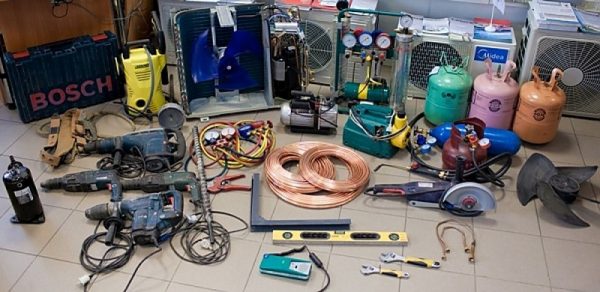
What can be useful for installing an air conditioner
In addition to tools, materials will also be required:
- Copper seamless pipes, which are necessary for the cooling and air conditioning system. Typically, the length of the pipe is equal to the length of the path in the wall plus 30-40 cm. The diameter will depend on the requirements of the manufacturer of the air conditioner.
- Electric cable - its amount is usually indicated in the instructions for the device, but it is better to take with a margin.
- Drain pipe - this will require a special or water-polypropylene. Its length should be 80 cm longer than the track.
- Pipe insulation - a rubber sleeve is best suited.
- Plastic box - it will be required to hide the track in the wall.
- Fasteners for the outdoor unit - ready-made corners and brackets are usually bought.
- Bolts, fasteners.
How to independently install air conditioning in the apartment
First you need to determine the installation location and its method. Air conditioners are installed in the apartments, the external and internal units of which are connected by a pipe in which there are wires and freon.
Important! It is better to independently engage in the installation of an air conditioner in spring or summer.
To install correctly do-it-yourself air conditioning, for starters, you should study the instructions. It indicates the necessary materials that will be required in the process. They are best purchased in advance.
The sequence of actions will be indicated there, in almost all cases they are identical:
- The wall marks the placement of the block, track and all other devices.
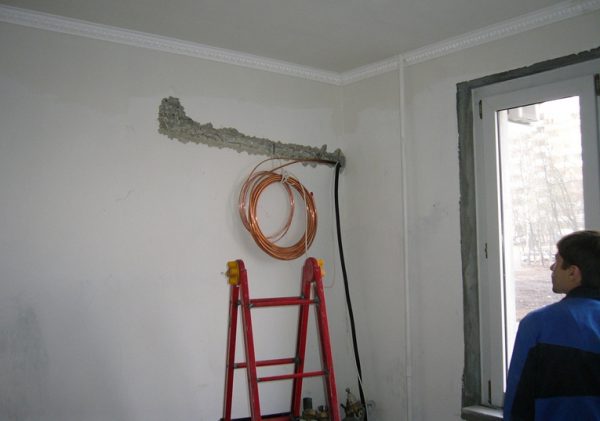
Track for system fixtures
- It is necessary to mark the location of the wiring in the wall. This can be done using a special device.
- Next, the plate of the indoor unit is attached. It should be horizontal (the construction level will help to level it). Then the plate itself is applied and places for drilling holes are marked. After that, they are drilled and fasteners are inserted there.
- Then the plate is put in place and carefully fixed.
- The outdoor unit is installed in the same way.
- The installation is checked for smoothness and everything is neatly fixed.
- A punch is used to make a through hole through which communications will pass.
After these actions, a track is laid in the wall.
Important! The number of fasteners should equal the number of holes in the block. Otherwise, the design may not support its weight.
How to install an external unit
All work begins with the installation of a capacitor, suitable brackets are selected that will support the weight of the air conditioner. It is better to fix them to the wall itself, and not to the insulation or cladding of the room.
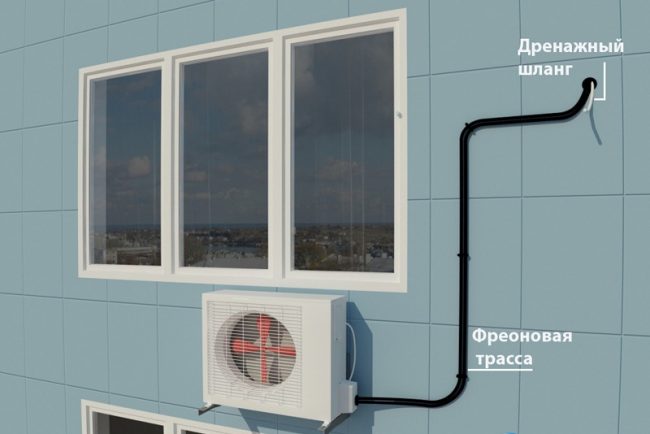
Mounting the system on the facade of a high-rise building
To protect the system from the adverse effects of the environment, it is covered with a visor.
The drain pipe from the outdoor unit should be discharged into the sewer.
How to install the indoor unit
The distance between the two blocks must be proportional to the power of the system. The smaller it is, the better the system works.
For this reason, the indoor unit is installed on the same wall as the external one. If this is not possible, then the closest place is chosen.
It is important to consider that:
- Air conditioning must not be installed above the bed.
- The distance to the ceiling should be at least 10 cm.
- Do not place over windows and batteries, or in an unventilated area.
- Do not place the air conditioner close to furniture.
It should provide free access to the device, this will improve its performance and allow timely cleaning.
Installation of the indoor unit is almost identical to the external. First you need to choose a place, then attach the brackets, and on them, the evaporator. The only difference is that before installing the indoor unit, you need to drill a hole for the freon tube.
After installing the entire system, the two units are connected, and the air conditioner is connected to the network.
How to connect blocks
Air conditioning units must be connected by copper pipes (2 pieces) and cable. They can be laid on the wall and hidden in a special box, or in a strob. In this case, you will need to make a groove. But first, you should drill a hole in the wall, which is done after installing the fasteners. Then the connection of the blocks begins, this will require:
- Pipes with a larger and smaller diameter, on which thermal insulation is worn.
- Then they are pushed through a hole in the wall and bent using a pipe bender.
- Special tips are put on both sides of the pipes to protect them.
- The wire is also held in the hole and connected according to the instructions. Each unit has terminal blocks to which wires will be connected, according to their colors.
- Then, a drain pipe is connected to a specific output of the indoor unit. The second end is displayed on the street.
- The drainage must be carefully fixed to prevent it from sagging.
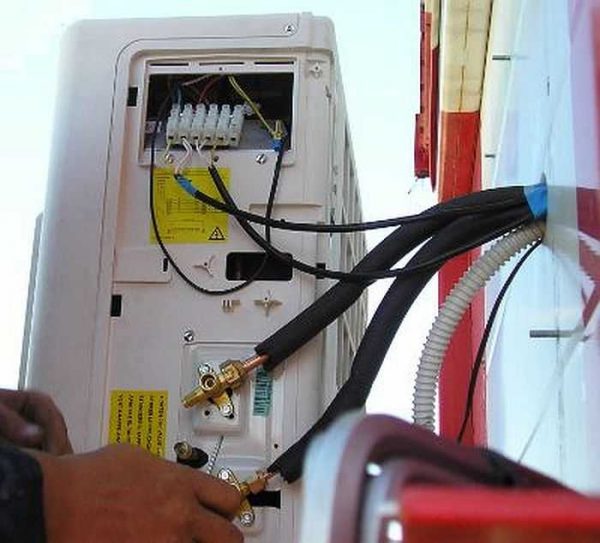
System block connection
If installation of a plastic box is required, then all communications should be bundled. This can be done with screeds or metallic tape.
How to connect the air conditioner to the mains
At the final stage of installation, copper pipes are connected and air conditioning drainage to the mains according to the scheme. With the latter, things are much simpler, at the bottom of the indoor unit there is a conclusion, it is there that the drainage is inserted.
After this, you must connect the copper pipes. You need to start work with the indoor unit.On its side wall there are two ports, one with large fittings and the other of small size. You can start with anyone.
The whole process of work is as follows:
- Remove the nuts from the copper pipe connections.
- Then the plugs are removed and the evenness of the edges is checked.
- Flare nuts are put on the pipes. It is important not to confuse the direction of the thread.
- The edges of the pipes are expanded and clamped in the holder.
- The roller is installed and the screw is tightened.
- End rolling should be after the cylinder stops lowering.
- The flared edge is held to the output of the indoor unit and, using a union nut, connects.
- The external unit is connected in the same way.
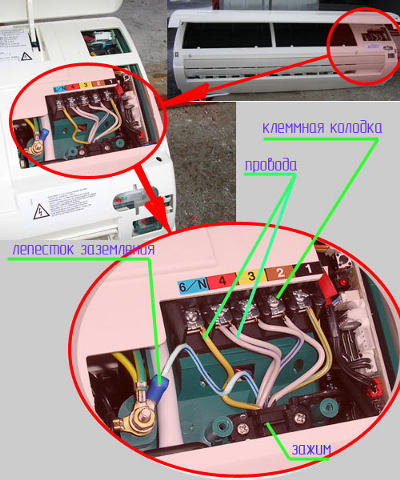
DIY connection of the air conditioner to the mains
The wiring diagram for connecting the air conditioner at home can only be single-phase. This can be done through a power outlet or using a wire to the electrical panel.
Using a power outlet
First, lay the cable from the evaporator to the outdoor unit. For this:
- A wire is laid to connect the blocks.
- A line is drawn to the electrical panel. This includes a cable and an overload protector.
- If the devices have medium power, then they can be connected without such a line. This is done directly to the outlet.
Important! The air conditioner can operate at different capacities, so the circuit breaker should be installed on the connection line and near the outlet.
How to choose a power outlet
It must meet the following requirements:
- Have a reliable ground.
- Meet the parameters of the air conditioner manufacturer.
- All wires must be copper.
- The socket must be connected to the panel through the circuit breaker.
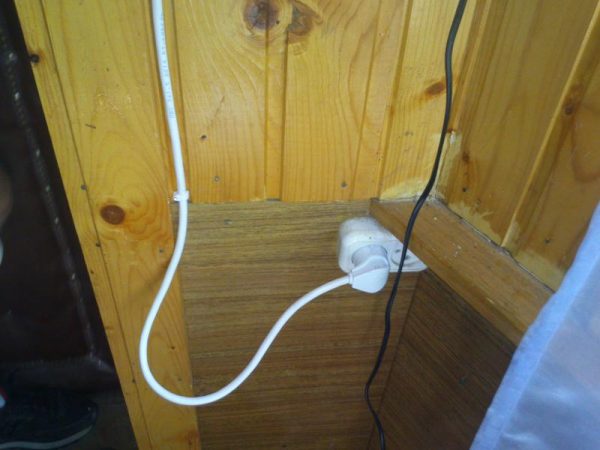
Socket for air conditioning system
Using a separate cable
This method is considered the most reliable and safe, especially if you install a trip protection device that protects the system from voltage surges.
Requirements for such a connection:
- Mandatory presence of a device or circuit breaker.
- All components must be copper.
- The diameter of the wires must correspond to the size specified by the manufacturer.
- A separate ground must be created for the entire line.
Then all cables are laid, and the operation of all components of the system is checked.
Height from air conditioning to ceiling
The most optimal height on which the air conditioner is hung is considered 10 cm from the ceiling. This will ensure the correct flow of cold air, which will pass upstairs. At the same time, there will be enough space for air circulation. However, for more powerful air conditioners, this distance can be increased by 5-10 cm.

The distance is calculated from the baseboard.
How to install a mobile air conditioner
Mobile air conditioning is much easier to install than any other. But here, some work skills will be required. The following toolkit is also needed:
- Thick plastic (thickness 10-12 mm). It will be required to create a barrier between cool indoor air and warm outside.
- Saw for plastic.
- Masking tape or tape with which the sheet is fixed.
- Polyurethane foam or any sealant that provides water and air tightness.

Mobile device installation option
It is best to place a mobile air conditioner near the window, while avoiding fractures on the air outlet hose. The installation procedure is as follows:
- All necessary measurements and the diameter of the air outlet are made.
- A hole is cut out for him. It should be 3-4 cm smaller than the pipe itself. This will help to fix it tightly.
- Plexiglas is sealed. This can be done with masking tape, sealant or foam.
- You need to open the window frame and fix the insert from plexiglass there. This can be done using the same tape or sealant.
- After that, you can install the candy bar itself.To do this, a place is chosen for its installation, a drainage hose is inserted into the air outlet, and it is inserted into the exhaust opening of the monoblock. The other end of the hose is led outside.
- After 2-3 hours you can turn on the air conditioner.
Installing an air conditioner without a vacuum pump
If the length of the route is less than 5 meters, then the air conditioner can be installed without a vacuum pump. This will require:
- Unscrew all stubs on ports.
- Next, take the hex key, which is selected according to the size of the lower port.
- Next, the key is inserted into the port and scrolls 90 degrees. At this time, freon comes out, which, together with air and freon, creates excess pressure.
- There is a spool at the port, which is compressed for a while. At this time, a mixture of gases will blow out, which carries air and argon.
- Next, repeat the previous steps. If the track is 4 meters, then this will be enough, if 3 - then you should repeat it again.
- A plug is screwed onto the spool outlet.
- With the help of a hexagon, the lower and upper port opens, where freon is admitted.
- The system is ready to go.
Installation of air conditioning on high floors
Installation of air conditioning on the upper floors of the house can be done on the roof. The distance between the blocks will be approximately 15-20 meters. This can be done using a crane and a sliding ladder.
If this option is not suitable, then the system can be installed on a balcony or under a canopy. In this case, it is necessary to consider the following points:
- The walls where the system is installed must be strong and withstand heavy weight.
- Do not mount on aerated concrete walls.
- Do not attach the system to a ventilated facade, as this will result in noise and vibration.
- Everything should be installed smoothly and without distortions.
- The distance between the outdoor unit and the wall should be at least 10 cm.
- Do not install the air conditioner on a glazed balcony, as this will impair its performance.
- Be sure to install a visor above the external unit, which will preserve the integrity of the system.
Air conditioning installation requirements
In order for the air conditioner to maximize the benefit, it is necessary to observe some rules:
- Choose exactly the model that matches the parameters of the room (dimensions, availability of equipment, etc.).
- Correct installation.
- Compliance with the rules of operation and prevention.
The air conditioner has two units, each of which has certain functions. The external is the condenser, and the internal is the evaporator. They are connected using wires, tubes, in which freon functions.
It is very important to choose the right place to install the system. In this case, the weight of the unit, free access to it and so on should be taken into account.

Install the air conditioner closer to the window
The external unit must be located on a strong wall that can support a weight of more than 60 kg. Do not mount on aerated concrete. The outdoor unit must be protected from environmental influences. This can be done using fences and awnings.
When installing the indoor unit, you should consider:
- The distance from the outdoor to the indoor unit should be kept to a minimum. This will provide higher efficiency.
- The evaporator must not be obscured by curtains, furniture, etc.
- There must be a distance of at least 3 meters between the furniture and the indoor unit.
- Do not install the system above batteries.
- Provide free access.
- The distance from the unit to the ceiling should be at least 10 cm.
It is necessary to ensure the tightness and reliability of the mounting of the air conditioner. If a trunk is used to connect the blocks, then evacuation of the joints will be required.
What is the maximum length of the air conditioner
As you already know, the larger the track, the lower the power of the entire system. The air conditioning passport indicates the maximum distance of the route. Typically, the vertical distance is 7 meters and the horizontal distance is 15 meters.
How to hide air conditioning in the interior
Usually, the air conditioner is installed during the repair, so it is better to choose an option that will fit into the interior without a win. If this failed, you can try:
- Paint the air conditioner in the color of the wall.
- Position it above the front door.
- Purchase an integrated split system that can be hidden in a suspended ceiling.
- Floor air conditioning can be hidden in decorative panels.
- Place the air conditioner in a shelf or cabinet where free air circulation will be ensured.
- You can make a niche for the block.
In this case, everyone decides which option will be more convenient. In any case, it is not worth clogging the passage to the fan, as this can lead to overheating and quick breakdown.
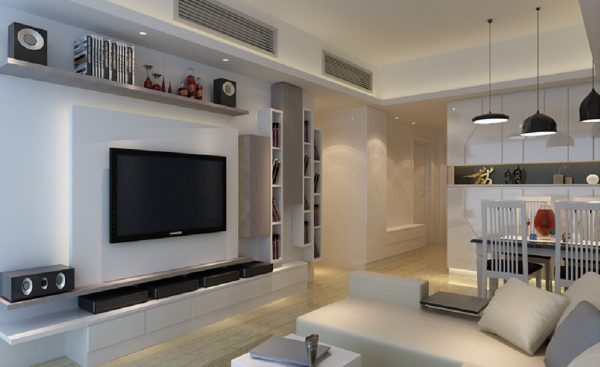
You can hide the air conditioning under the ceiling
In the hot season, air conditioning is a must. It is very important to install it correctly, otherwise the whole system will not be able to function and will quickly fail. If you do the installation yourself, you must follow all the rules, and before that, study the manufacturer's installation instructions. This will help to quickly and easily do all the work.

